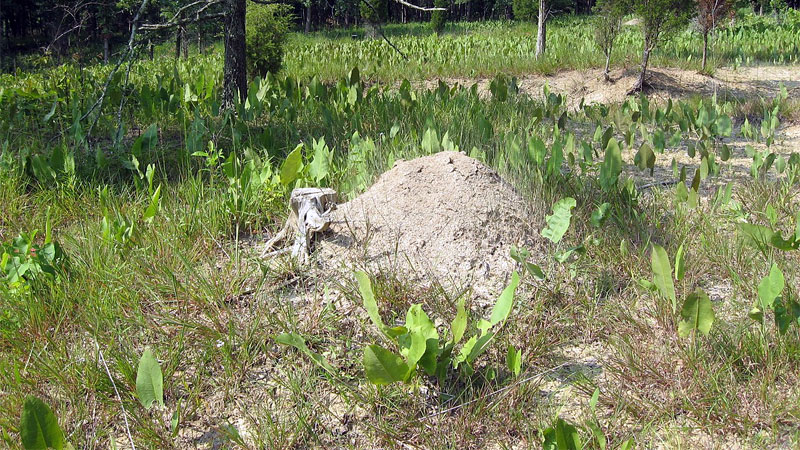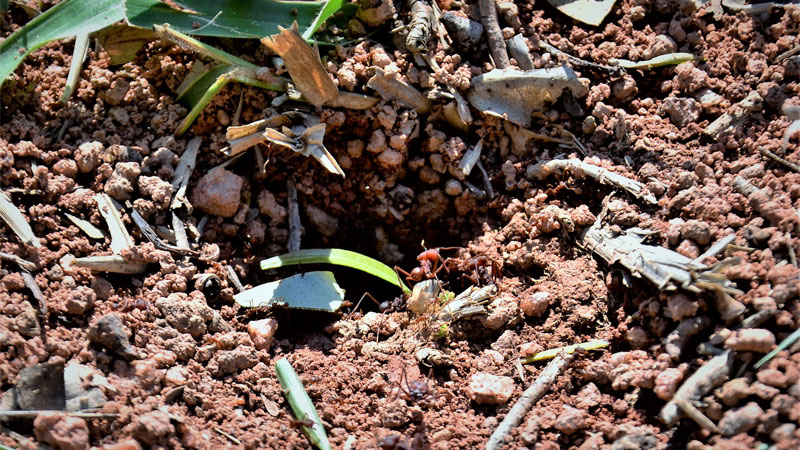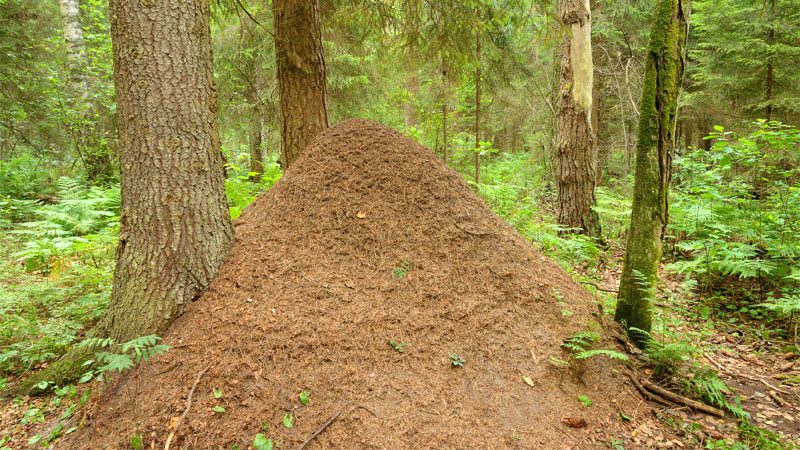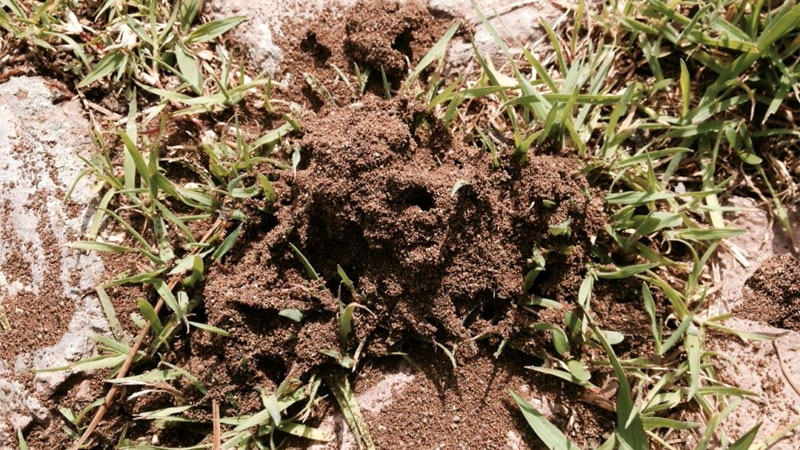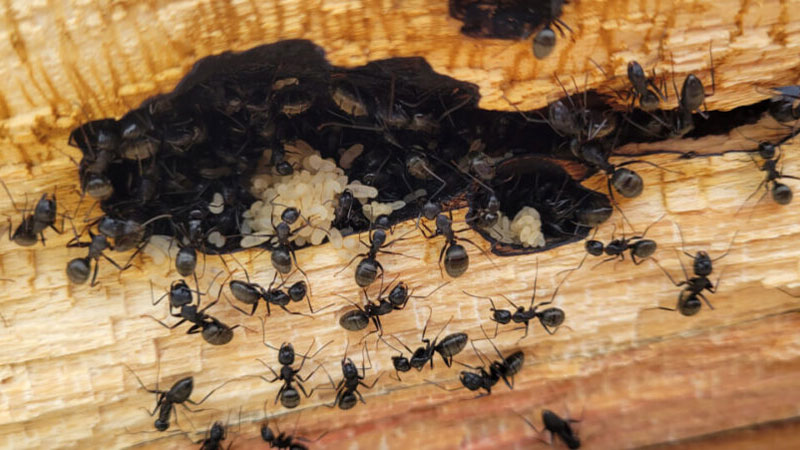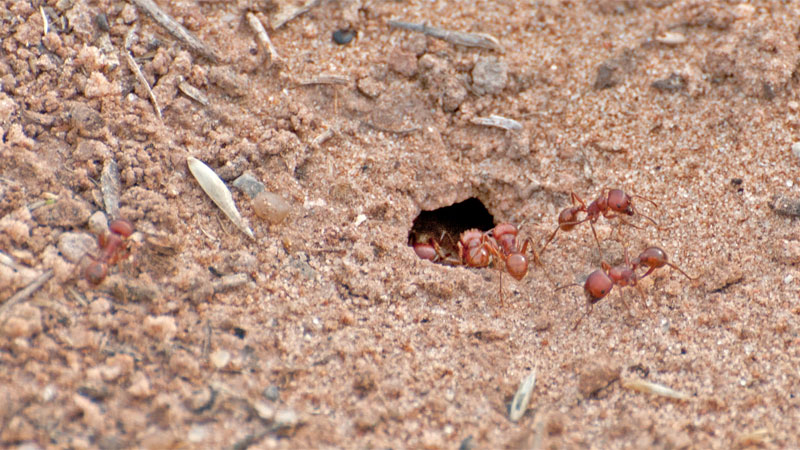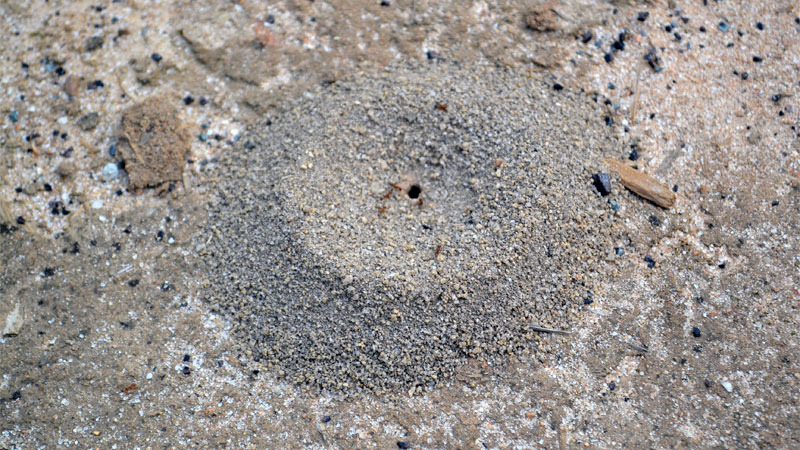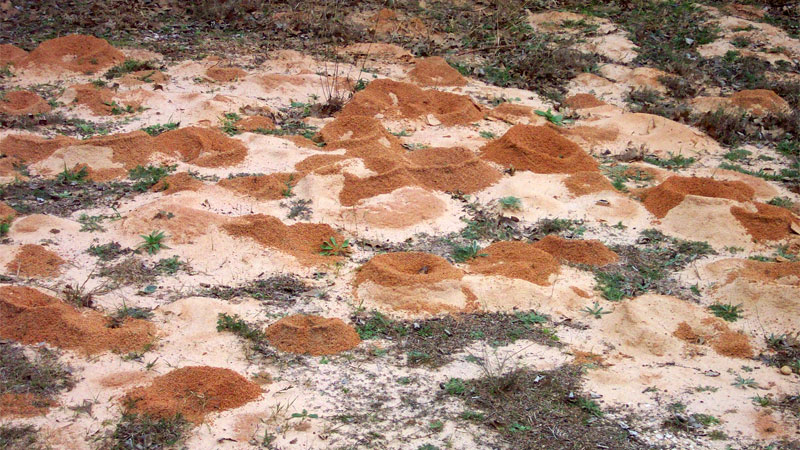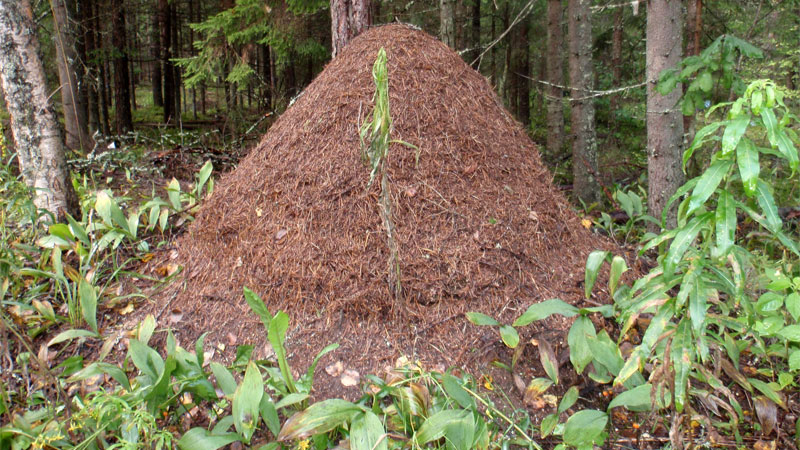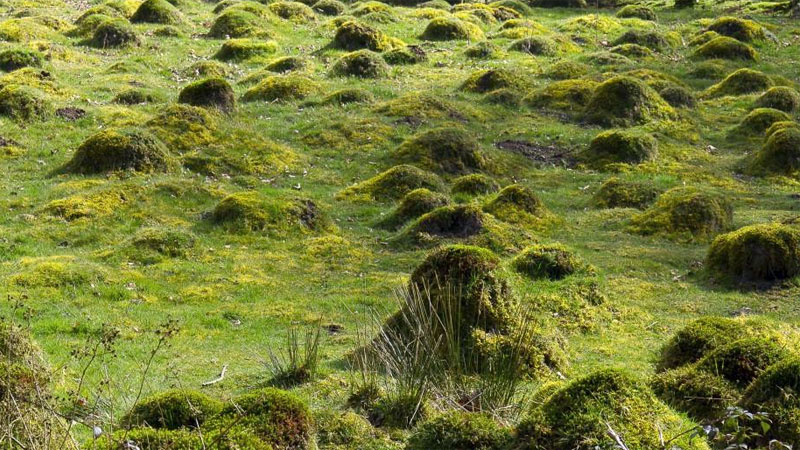Ants are some of the oldest living fossils in the world, and one of the most abundant critters on the planet. But something that has perhaps fascinated people even more than the ants are their mounds.
The term “ant mound” can have a few different meanings and not all ants build them. Those that do can build some pretty varied designs. Here are 12 different types of ant mounds plus one imposter type. After, we’ll look at some common questions regarding these structures and the term itself.
Types of Ant Mounds
#1 – Allegheny Mound Ant Mound
The Allegheny mound ant (Formica exsectoides) is a field ant that’s earned its name. These mound building ants create entrances up to three feet tall and six feet across. During the construction process, they actively destroy nearby vegetation to ensure the mound won’t be damaged.
Despite the novelty of seeing such huge dirt mounds in the US, it’s best to steer clear. Not only do Allegheny mound ants actively use two related species for slave labor, they’re also highly aggressive if their nest is disturbed.
#2 – Ant Bed
An ant bed isn’t where an ant sleeps, but rather the name of the little pile of debris surrounding the entrances to a nest. These little barriers serve a very real function, providing a fortification around the entrance that helps prevent flooding and other dangers.
They’re often made of excavated materials such as clay, pebbles, sand, or soil. However, they can also include harvested materials including manure, pine needles, or even use urine as a mortar.
The bed is built with new materials placed at the top to tumble outwards, preventing debris from falling back into the nest. Over time, rain can make these beds harden, at which point they may begin to grow into ant hills.
#3 – Ant Hill
When you think of ant hills, you might think of huge mountains of earth from which thousands of ants emerge. Sadly (or not), this is usually far from the truth.
Some ants do indeed built mounds large enough that we call them ant hills, but quite often these are either termite mounds or very old hills. These hills sometimes become extensions of the colony itself, containing its own series of chambers and tunnels.
All types of ant hills begin as mounds. Over hundreds or even thousands of generations of ants, they expand into full-sized hills. As the colony ages and grows, more and more debris is collected at the entrances, causing the mounds to eventually reach several feet in height.
It’s almost unheard of to find a full-sized ant hill in the US. They’re far more common in Africa and South America. Why is this? Simply put, few places in the US are left undisturbed long enough for this to happen.
#4 – Argentine Ant Mound
One of the top 100 worst invasive species in the world, the Argentine ant (Linepithema humile) is also one of many ant species that have multi-queen colonies and an aggressive disposition. Thus, they can end up with extremely large colonies, which break off into satellites as needed.
This means that you’ll likely find a number of mounds within a radius of the parent mound. The ants can often be seen traveling between mounds as needed.
The mound itself is generally made of loose soil, although their nesting habits mean you may not always see mounds. For example, they prefer building shallow nests in cracks and crevasses, which may or may not result in debris. You’ll also find them nesting in loose leaf litter or under stones. Even worse, they can set up colonies in your house.
Argentine ants sometimes take over the abandoned nests of other ant species. Because of how stable their genetics are, it’s common for Argentine ants of one colony to peacefully intermingle with those of other nearby colonies, resulting in super colonies.
#5 – Carpenter Ant Mound
When you think of carpenter ants (Camponotus spp.), you likely picture ants digging through your walls. But don’t mistake them for termites as these ants don’t actually consume wood and instead subsist entirely on liquids. They prefer damp, dead wood and are valuable help when it comes to decomposing rotting wood.
Depending on the species, carpenter ants build their nests either completely in wood or (especially in the case of fallen logs) partly in the wood and partly the ground beneath. The ants create special vents on the side of their nest called kick holes.
They use these holes to kick the indigestible wood pulp and ant frass out of the nest, resulting in piles that resemble sawdust. Inside the home, these piles are often the first indication of a carpenter ant infestation. Both frass piles and ground excavations can resemble mounds, although only the latter may be an entrance to the ant colony.
#6 – Fire Ant Mound
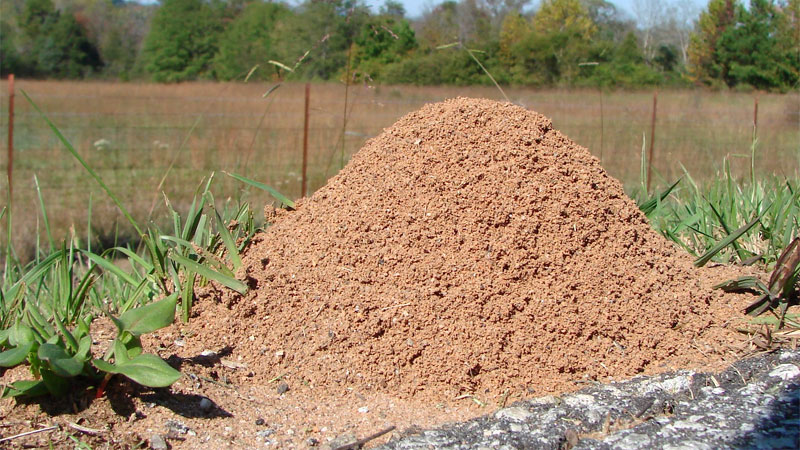
Fire ants (Solenopsis spp.) are native to South America, but some species have found their way further north, including the infamous Red Imported Fire Ant (Solenopsis invicta).
They have a rather peculiar mound structure made of loose materials that can reach as high as 16 inches tall in lighter soil with heavier soils resulting in mounds as high as 42 inches tall and nearly five feet wide for mature colonies.
What makes these hills even more curious is the fact that the fire ants don’t generally build them. Under normal circumstances, fire ant nests are located underneath cover, such as logs, masonry, or stones. In these cases, the fire ants prefer moist soils where it’s easier to tunnel.
You’ll see those rarer fire ant mounds in open spaces such as lawns or fields. Fortunately, a good fire ant killer works wonders on the colony and any structures being built regardless of location.
#7 – Harvester Ant Mound
The term “harvester ant” actually applies to any ant species that harvests seeds or mushrooms. As such, their mounds can vary in size and shape. However, while some hide their nest entrances under debris, others do create visible mounds.
#8 – Pavement Ant Mound
Pavement ants build small to medium-sized ant hills that can be found in the cracks of sidewalks, driveways, and other pavement surfaces. These mounds are made up of soil and sand particles and are usually no more than a few inches in diameter.
This type of mound can be identified by the presence of worker ants moving in and out of the mounds. They can number in the dozens along a single bit of sidewalk, as a single colony can have between 3,000 to 10,000 individual ants and multiple queens.
#9 – Pyramid Ant Mound
Pyramid Ants (Dorymyrmex spp.), also known as cone ants, generally don’t have very large colonies and tend to be completely docile. They’re known for their more pointed thorax and the rotting coconut smell they give off when crushed.
A pyramid ant mound is conical in shape, with a single entrance and a central crater that acts as ventilation. This gives their mounds a volcanic appearance. As they tend to prefer warmer climates, they’re generally adapted to life in sandier or drier soils.
This also has an impact on mound composition. If you have pyramid ants in the grass portion of your yard, their mounds may be tough to spot.
However, this is one of many genera of ants that are known to invade homes, meaning the invading colony won’t have a visible mound unless they’re trailing in from an outdoor colony. Strategically placed ant traps are usually the best line of defense against pyramid ants, sugar ants, thief ants, and pavement ants.
#10 –Texas Leafcutter Ant Mound
Move over Texas Chainsaw Massacre and make way for the Texas leafcutter ant (Atta texana)! Obviously, this type of ant is found in Texas but it’s also known to be in Louisiana and other nearby states.
These agricultural ants harvest leaves to take back to their nests, which they use to cultivate fungus farms. A single colony can have as many as two million workers and is capable of completely defoliating a citrus tree within 24 hours.
Their mounds further illustrate this ruthlessness, as a single nest can have up to 1,000 entrance holes. Much like pyramid ants, the mounds are roughly shaped like a volcano, measuring anywhere from five to 14 inches tall and at least 12 inches across.
The mounds are closely packed together, allowing for the ants to decimate nearby greenery with maximum efficiency.
#11 – Wood Ant Mound
Wood ants belong to the subgenus/species group (it’s complicated) Formica rufa. Members in this group are named after the red wood ant. They’re rather famous for their ant mounds, which are made up of debris, grass, or needles.
These hills can reach impressive heights, with the Scottish wood ant (Formica aquilonia) having mounds as high as 8.2 feet tall! Formica polyctena also builds massive mounds out of buds, pine needles and sap.
This latter species is especially fascinating because the mound is designed to keep the nest at a stable temperature. Not only does the amount of material in the mound insulate the nest, but it also decomposes into natural compost.
During decomposition, its internal temperature increases due to the microbial activity occurring. This heat then funnels down into the nest itself, ensuring the ant larvae are well incubated. As the inner material becomes fully broken down, the ants add more to the exterior to continue this composting process.
#12 – Yellow Meadow Ant Mound
The yellow meadow ant (Lasius flavus) prefers to conceal its nests in living vegetation and will frequently make their homes in lawns and meadows. In a pinch, they’re also known to nest under rocks or other cover.
They build mounds which can be as high as 20 inches, but what’s curious is the way these mounds are both hidden in the grass and easily spotted.
This is because yellow meadow ants are ranchers. They breed root-eating aphids in their nests which feast upon the grasses above, providing the ants with honeydew. The aphids sometimes also harvested as food during the winter.
The result is a growing ring of dead ground around the nest, yet any grass that overgrows the mounds will be left untouched.
#13 – Bonus Imposter Mound: Termite Mounds
You’ve probably seen photos describing these as merely different types of ant hills, but termites aren’t ants. In fact, they’re actually close siblings to roaches. The good news is termite vs ant mound identification is easy.
Termite mounds tend to be vertical and almost chimney-like. It’s extremely rare to see them in the US. Instead, they’re more common in Africa and other regions where the termite colonies are left undisturbed for many generations.
While fascinating to look at from a distance, it’s scary to imagine one appearing here.
Common Questions Regarding Ant Mounds
You’ll find many types of ants from California to Florida and even Alaska. They’re found in the fossil record and have barely changed over millions of years. Oddly enough, however, this lack of overall change has still led to an organically diverse group of insects.
Ants can have surprisingly complex cultures and a striking amount of variation in size and shape – sometimes within a single species. We’re also beginning to understand that they’re far more intelligent than humans give them credit for.
We can see this intelligence in how (and why) so many species build ant hills and mounds.
What is an Ant Mound?
Let’s be perfectly clear here: the term “ant mound” can mean a couple different things.
For some, it’s a reference to the visible mounds above a nest. For these people, mounds can be big or small, and are interchangeably called ant hills (two words). In many regions, a distinction between the terms “mound” and “hill” directly reference the size.
However, for others, including many myrmecologists (those who study ants), the term “ant mound” instead refers to the nest itself when below ground, as well as any above-ground nest sections inside an “anthill” (one word). Confused?
According to the Cambridge dictionary, an “anthill” is “a pile of soil created by ants when they are making their nests underground”. This is because the term refers to the debris field created by excavating the nest, not the inhabited areas. Myrmecologists make this distinction, but most people don’t care if the hill is inhabited.
For the sake of accessibility, we stuck with the vulgar (i.e. common) definitions of ant mound and ant hill for this article.
What Do Ant Mounds Look Like?
Ant mound identification often leads to identifying the ants responsible and vice-versa. This is because different mound building ants will build different looking mounds. Some are almost flat, while others can be several feet tall.
Many have a central crater like a volcano. In some cases, the mound many have tunnels exiting the sides.
What Kind of Ants Make Mounds?
While not all species make mounds, a lot of pest species such as acrobat ants and odorous house ants do. That is, if they’re not busy setting up their home in yours.
Ant queens will often begin the first mound after their mating flight as they burrow underground. From there, workers will create additional entrances, resulting in multiple mounds as the nest expands.
What are Ant Mounds Used For?
There are five major uses for an ant mound, depending on the species building it:
- The mound is simply a debris field from excavating the nest.
- The mound acts as a barrier to help prevent flooding.
- Species with larger colonies sometimes build their hills to create additional living space.
- Some species use the mounds for temperature regulation and store larvae or food there.
- Some species of harvester ants or livestock-raising ants use the interior of the mounds for food production.
Should I Worry About Ant Mounds?
This can depend on where the mound is and what species made it. For example, pavement ants and other species that nest under sidewalks can cause the walk to shift over time.
Other species can damage your lawn or garden when making their underground tunnels. And obviously, you don’t want an aggressive species hanging around.
But for the most part, ant mounds are considered mostly harmless. Their construction can play an important role in aerating the soil.
If you’re worried about the placement (or creator of) ant hills on your property, you can get rid of them yourself or hire a pest control professional to do the job for you.
- How to Get Rid of Hawks - March 8, 2024
- How to Get Rid of Pill Bugs (Rolly Pollies) - March 1, 2024
- How to Get Rid of Groundhogs (Woodchucks) - February 5, 2024


